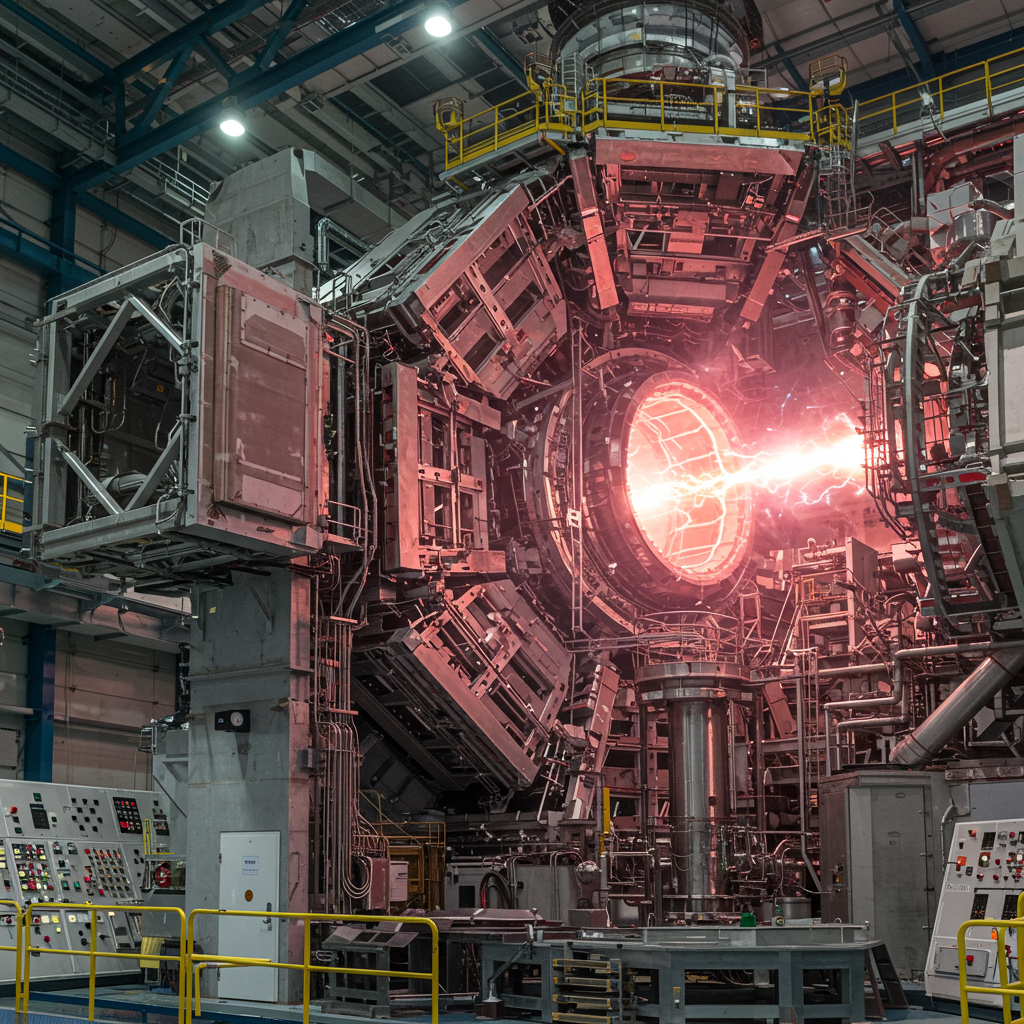The global pursuit of clean, virtually limitless energy just saw a dramatic leap forward. In a stunning scientific achievement, researchers in France have shattered records by sustaining a nuclear fusion reaction for an unprecedented duration. This milestone ignites fresh optimism that the dream of harnessing the power of stars here on Earth is inching closer to becoming a reality, potentially reshaping the future energy landscape.
The Elusive Promise of Fusion Energy
For decades, scientists worldwide have chased what’s often called the “Holy Grail” of energy: nuclear fusion. This is the fundamental process that fuels our sun and other stars, where light atomic nuclei merge under immense pressure and temperature to form heavier nuclei, releasing vast amounts of energy. Imagine a world powered by fuel readily available from water, producing virtually no greenhouse gases or long-lived radioactive waste. One tiny gram of deuterium-tritium fuel could theoretically generate as much energy as 11 tonnes of coal – an astonishing density that underscores fusion’s potential to meet humanity’s growing power demands sustainably.
Achieving this feat on Earth, however, is incredibly challenging. It requires recreating stellar conditions: temperatures exceeding 100 million degrees Celsius (far hotter than the sun’s core) and pressures high enough to force positively charged nuclei to overcome their natural repulsion. Sustaining a stable plasma – a superheated, ionized gas where fusion occurs – for extended periods has been a monumental technical hurdle, demanding sophisticated containment methods like powerful magnetic fields.
France Sets a New World Record
On February 12th, a team at France’s Commissariat à l’énergie atomique et aux énergies alternatives (CEA) announced a landmark achievement using the WEST Tokamak reactor. They successfully maintained a high-performance plasma state for an astonishing 1,337 seconds, equivalent to over 22 minutes. This feat didn’t just slightly exceed previous records; it represented a significant leap in sustained plasma duration for this class of reactor, decisively surpassing the previous record of 1,066 seconds held by China.
This record isn’t just about holding plasma longer; it proves critical systems can endure extreme conditions. According to Anne-Isabelle Etienvre, CEA’s Director of Fundamental Research, this success validates the resilience of the materials and magnetic systems used in the WEST Tokamak. It demonstrates that components designed to withstand the intense heat, neutron bombardment, and electromagnetic forces within the reactor can perform reliably over extended operational cycles. This sustained operation is vital for the eventual development of commercial fusion power plants that need to run continuously for long periods.
Why Sustaining Plasma is So Difficult
Holding a plasma at temperatures over 150 million Kelvin (five times hotter than the sun’s core) is an immense engineering challenge. Superconducting magnets must precisely contain the turbulent plasma, preventing it from touching the reactor walls. Materials used in the reactor must withstand constant exposure to high-energy neutrons produced by the fusion reaction without degrading. Cooling systems must dissipate enormous heat loads efficiently. The ability to maintain stability and integrity under these punishing conditions for 22 minutes marks a crucial step forward, demonstrating mastery over complex control systems and material science previously thought unattainable for such durations.
The Role of the WEST Tokamak in the Global Race
The WEST Tokamak, located at CEA’s Cadarache center, serves a crucial role as a testbed for future fusion reactors. Its full name, Tungsten Environment in Steady-state Tokamak, highlights its focus on using tungsten for its plasma-facing components. Tungsten is favored for its high melting point and resistance to erosion, essential properties for enduring prolonged plasma exposure. The data gathered from experiments at WEST, particularly regarding material behavior and plasma control during long pulses, are invaluable.
These insights directly inform and de-risk the design and operation of the International Thermonuclear Experimental Reactor (ITER). Also under construction in southern France, ITER is the world’s largest fusion project, a collaboration involving 35 nations. While WEST focuses on long-pulse operation and material testing, ITER aims to be the first fusion device to produce net energy – specifically, ten times more energy than is put in to start the reaction (a Q=10 gain). The success of projects like WEST is therefore foundational to ITER’s ambitious goal of demonstrating the scientific and technological feasibility of fusion power on a commercial scale by the mid-2030s.
Looking Towards ITER and Beyond
Dr. Maria Schaefer of the International Energy Agency has stressed that the success of ITER heavily relies on data gleaned from smaller, pioneering projects like WEST. These experiments refine complex physics models and engineering tolerances, reducing uncertainties as researchers scale up to the massive ITER device.
The quest for fusion power doesn’t stop with ITER. The field is vibrant with innovation, exploring diverse concepts like compact spherical tokamaks, which could potentially offer smaller footprints and faster construction times, and stellarators, which use different magnetic field configurations for plasma confinement. This global effort resembles a relay race, with each experiment building upon the successes and lessons learned by others, all sprinting towards a carbon-free energy future.
Challenges Still Ahead
Despite exciting breakthroughs like the one at WEST, the path to commercial fusion power plants remains challenging. Significant technical hurdles persist, including developing materials that can endure decades of intense neutron bombardment without becoming brittle or radioactive, building superconducting magnets that can operate flawlessly for years, and designing components capable of handling immense heat loads reliably.
Integrating fusion power into existing electricity grids presents another challenge, particularly managing potentially variable output and ensuring grid stability. Furthermore, the economic feasibility of fusion power is still being assessed. Can the cost of building and operating these complex machines compete with increasingly affordable renewable sources like solar and wind, even considering fusion’s unique advantages of minimal emissions and continuous, weather-independent power generation?
The Undeniable Promise and Future Outlook
Despite these hurdles, the potential benefits of fusion energy are profound. It offers an almost limitless, intrinsically safe, and clean energy source that could play a critical role in combating climate change and ensuring global energy security for centuries. The International Atomic Energy Agency (IAEA) estimates that if development roadmaps proceed as planned, fusion could contribute up to 4% of the global electricity supply by 2040.
The achievement at the WEST Tokamak is more than just a technical record; it’s a powerful symbol of progress and persistence. It validates decades of research and billions of dollars invested globally. While patience, precision, and substantial funding are still required, each successful plasma pulse, each sustained reaction, brings the transformative dream of abundant, clean fusion power closer to reality.
Frequently Asked Questions
What is the significance of the 22-minute plasma duration record achieved by the French reactor?
The record of 1,337 seconds (over 22 minutes) set by the WEST Tokamak is highly significant because it demonstrates the ability to maintain a stable, superheated plasma state under extreme conditions for a prolonged period. This isn’t just a technical feat; it proves the durability and resilience of the reactor’s components, particularly its tungsten walls and magnetic systems. Sustained operation is crucial for the feasibility of future commercial fusion power plants that need to run continuously, making this a vital validation step for the technology.
Where is the WEST Tokamak located, and how does its research support the larger ITER project?
The WEST Tokamak is located at the CEA’s research center in Cadarache, in southern France. Its research directly supports the International Thermonuclear Experimental Reactor (ITER), which is also under construction nearby in southern France. WEST acts as a crucial testbed, focusing on specific challenges like material performance (using tungsten) and long-pulse plasma operation. The data, insights, and operational experience gained from WEST experiments are invaluable for refining the design, physics models, and engineering tolerances of the much larger and more complex ITER facility, helping to pave the way for its success.
When could fusion energy realistically contribute to the global power supply?
While significant progress is being made, commercial fusion power plants are still considered decades away. The ITER project aims to demonstrate the scientific and technological feasibility of fusion on a power-plant scale by the mid-2030s. However, transitioning from demonstration reactors like ITER to widespread commercial deployment involves further engineering, economic, and regulatory challenges. Estimates from organizations like the IAEA suggest fusion could potentially contribute up to 4% of the global electricity supply by 2040, but broader adoption is more likely expected in the 2050s or later as technology matures and costs become competitive.
The Journey Continues
From early concepts to this remarkable 22-minute glow in a French reactor, the quest for fusion energy has been a testament to human ingenuity. The road ahead still holds challenges, demanding further innovation in materials, magnets, and economic viability. Yet, the success at WEST provides concrete evidence that we are steadily advancing. As projects like ITER push boundaries and new concepts emerge, the prospect of a future powered sustainably by the process that lights the stars feels increasingly tangible. This record is more than a number; it’s a beacon guiding us toward a cleaner, more abundant energy future.




